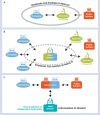The case for open-access chemical biology. A strategy for pre-competitive medicinal chemistry to promote drug discovery
- PMID: 19721463
- PMCID: PMC2750055
- DOI: 10.1038/embor.2009.193
The case for open-access chemical biology. A strategy for pre-competitive medicinal chemistry to promote drug discovery
Conflict of interest statement
The author declares no conflict of interest beyond his affiliation to the Structural Genomics Consortium as noted below.
Figures



References
-
- Avvakumov GV, Walker JR, Xue S, Li YJ, Duan SL, Bronner C, Arrowsmith CH, Dhe-Paganon S (2008) Structural basis for recognition of hemi-methylated DNA by the SRA domain of human UHRF1. Nature 455: 822–825 - PubMed
-
- Betz UA (2005) How many genomics targets can a portfolio afford? Drug Discov Today 10: 1057–1063 - PubMed
-
- Booth B, Zemmel R (2004) Prospects for productivity. Nat Rev Drug Discov 3: 451–456 - PubMed
Publication types
MeSH terms
Grants and funding
LinkOut - more resources
Full Text Sources

